| Somalia | Afghanistan | ||
| 1884–1954 | independence struggle and Ogaden split with Ethiopia | 1838–1893 | Indedependence struggle and Durrand Line border |
| 1969 | Coup and socialist military regime under Barre | 1973 | Daoud coup |
| 1977 | Ogaden war | 1978 | Socialist coup |
| 1980 | Switch to US backing | 1980 | Soviet invasion, US backs rebels |
| 1991 | US overthrows socialist leader | 1989 | Soviet withdrawal |
| 1990s | Warlord chaos -> Shabab | 1990s | Warlord chaos -> Taliban |
| 2001 | US bombing Shabab | 2001 | US invasion, bombing Taliban |
| 2006 | US rejects ICU truce | 2006 | Taliban resurgence |
| 2007+ | US drones and bombs | 2007+ | US troop surge, drones, bombs |
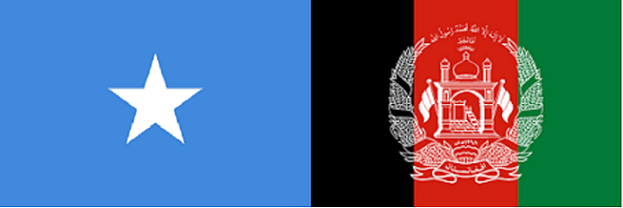
Somalia achieved independence only in 1960, and major general Said Barre took power in a coup in 1969. By the 1970s, Somalia was prospering, free of British/ Italian ‘protection’, socialist, a model third world state from the Soviet point of view, not yet targeted by the US. Ethiopia had a Nasser-like military coup in 1974 promising socialism next door. Sudan was at peace and pursuing a Nasserist policy under Colonel Gaafar Nimeiri. Nkruma’s dream of a united socialist Africa looked like it might actually be coming true.
At the top of the world, Afghanistan was following a similar trajectory, though somewhat delayed. It had been left in peace since the 1920s, recognizing and living peacefully with the socialist monolith to the north, slowly modernizing. But, just as in Somalia, its intelligentsia was attracted to socialism.
The Soviet Union was a good neighbour, providing aid and education. It also supported Afghanistan on the Pashtunistan issue.
Pakistan, Afghanistan’s bug bear, was especially anti-communist, hostile to socialist India over Kashmir, a ‘strategic ally’ of the US. The uninspiring king was overthrown by his cousin, who wanted ‘Pashtunistan’, in 1973.
The Soviet Union was not interested, and when the communists were arrested in 1978, they took power. But the world was a different place than 1969. The Afghan communists never had a chance.
Despite their similar beginnings and very different trajectories, both countries ended up as failed states, still being droned and bombed by the US in the pursuit of empire.
Swashbuckling histories, imperial revenge
Somalia has a population of 12.3m vs Afghanistan’s 32m. It has one of the most illustrious histories among Muslim states, prosperous for thousands of years as a trading nation perched on the strategic Horn of Africa, an early convert to Islam.
As with all of Africa, it went into sharp decline in the late 19th century, after the Berlin conference of 1884, when European powers began the “Scramble for Africa”.
In the last heroic resistance to imperialism, the Dervish leader Mohammed Abdullah Hassan rallied support from across the Horn of Africa and begin one of the longest colonial resistance wars (20 years).
Hassan emphasized that the British “have destroyed our religion and made our children their children” and that the Christian Ethiopians in league with the British were bent upon plundering the political and religious freedom of the Somali nation.” While all other Muslim states fell to Christian invaders, Somalia held out.
When the Ottoman caliphate collapsed and Britain ‘won’ WWI, Churchill was free to use the new aeroplanes in 1920 to bomb the “mad mullah” and Somali forces, just as Churchill was doing in Iraq. It took four invasion attempts before Hassan’s Dervish state was defeated, and territories turned into a British ‘protectorate’.
So, in 1921, the British took the southern half, Italy took (most of) the northern half. The two colonial powers were busy drawing artificial borders as if in a reality Great Game. They argued politely over Ogaden, but the US was calling the shots in the post-WWII era of decolonization, and Christian Ethiopia was able to get US support for the region (where borders were vague and most inhabitants ethnic Somali pastoralists) in 1954.
Britain and Italy, the ‘protectors’ of Somalia, had no say in the matter. The colonial border was a line right through the middle of Ogaden, populated mostly by Somalis, made by actors in London, Rome and Washington.
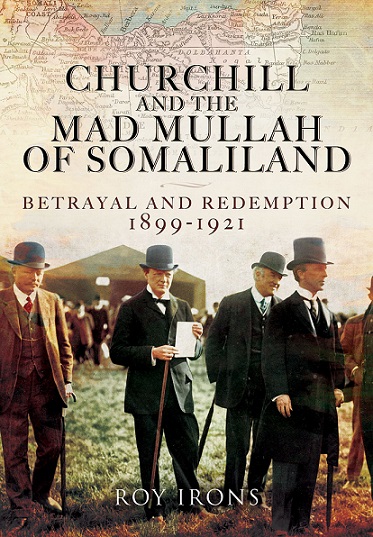
When Somalia finally achieved independence in 1960, it was left a time bomb ticking on the border with Ethiopia.
Afghanistan has a shorter history as a unified nation, but equally illustrious. Before Islam was introduced, people of the region were mostly Buddhists and Zoroastrians. In the early 16th century, Babur made Kabul his capital before invading India to found the Mughal Empire. Afghanistan became a separate nation only in 1737 under Ahmad Shah Durrani.
It waged three wars against British imperialism in the 19th century (killing all troops and British civilians in 1842). Britain finally forced Amir Abdur Rahman Khan to sign an agreement in 1893, dividing Afghan’s Pashtuns from those across the border in Britain’s Raj, the so-called Durand Line, a time bomb exactly like the southern border of Somalia.
Time bombs
Pashtunistan and the Durand line created a burning resentment that prompted the Afghan Shah’s cousin Daoud to oust him. But the Soviets were not interested in supporting a war with Pakistan. They were playing the ‘great game’ by detente rules.
So the nationalist Daoud turned against the Afghan communists, prompting them to carry out a coup in 1978. This created the conditions for civil war and their overthrow.
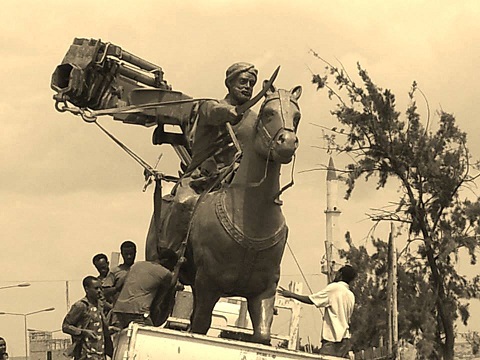
Toppling Hassan, Somalia’s national hero 1991
This was the identical scenario as Somalia and Ogaden When Barre tried to fashion a new (reasonable) border on his own terms in 1977. The Soviets were trying to play by detente rules and refused to support this. This sparked war with Ethiopia and the collapse of socialist Somalia.
The US propped up the now discredited socialist Barre (‘our S.O.B.’) and then arranged his ouster in 1991, with the collapse of the Soviet Union. After Barre fell, Somalia was ruled by warlords, awash with lethal western arms. ‘Black Hawk down’ was a wake-up call in 1992.
The same warlord scenario was playing out in Afghanistan in the 1990s as well. The last communist leader, Najibullah, was murdered in 1995. The same reaction –rural, devout Islamists, with a burning hatred of the US, filling the power vacuum.
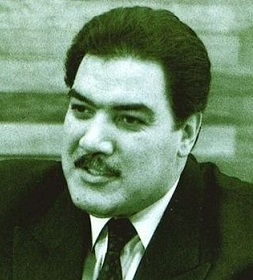
Counterfactuals
Instead of undermining both countries, why couldn’t the US have played by detente rules? Worked with the Soviets in Africa, pushing Barre out of his ‘greater Somalia’ in 1980, to keep a lid on Muslim extremists, and arrange a negotiated settlement with Ethiopia?
And in central Asia, help stabilize the socialist secular regime of Babrak Karmal in 1980, also alongside the Soviets, to fight the Muslim extremists?
If the US had worked with the Soviets, rather than playing a zero-sum game, both Ogaden and Pashtunistan could have been managed.
The 1970s were the years of detente, which should have meant peaceful negotiations, a modicum of trust. The Soviets did not support Barre’s invasion of Ethiopia, nor did they want to send troops to a faltering Afghan regime. They were eager for cooperation with the US.
Alas, the US under Reagan launched old-fashioned war and subversion of anything that was socialist (Islamist was okay for the time being in Afghanistan). Their victories against the Soviet Union were pyrrhic, leaving only rubble and terror in Somalia, Ethiopia and Afghanistan, a ‘solution’ which continues to plague the world in the form of ISIS (terrorisme san frontieres).
So is there any good news, any lessons from Somalia for Afghans? For the US?
Refugees
US policy in Somalia and Afghanistan from 1979 on helped reduce these countries to failed states (don’t forget Ethiopia). It created massive refugee populations, trying to squeeze into the imperial centre, where there was much less terrorism and lots of commodities to buy. This was not intended though it should have been foreseen, and has been a headache for the West ever since.
There are more than one million Somali refugees, spread from Sweden to the US, and Somalis abroad are forced to downplay the clan system, though it still exists where enough of one clan can form a community. But the second generation exiles are not interested.
The deadly clanism of Somalis is tempered in the West. Somali exiles are almost like a new set of clans. The American Somalis are “a bit more outgoing, they like to push things harder.”

Congresswoman Ilan Omar
One star of the Somali American diaspora is Congresswoman Ilhan Omar, who has rocked Capitol Hill since she gained her seat in 2016. Who would have thought a Somali woman would peacefully upset US political life? And to do so in the face of Trump’s travel ban on Somalis?
For three decades, Afghanistan has been the largest refugee-producing country in the world. The US and International Security Assistance Force countries grudgingly took in only a small number of Afghans that worked with their respective forces.
Far fewer made it to the far-off West than did Somalis (130,000 Afghans in the US and Canada in 2016). So, not much of a gravy train of US dollars remitted to Afghanistan by emigres, unlike Somalia, with its greater western diaspora and smaller size. On the contrary, the billions in foreign ‘aid’ from the US and its NATO henchmen have disappeared, like the Taliban were supposed to.

Omar Mateen
The most famous Afghan emigre is Zalmay Khalilzad, who, though unelected (unlike Omar), was at the heart of US strategy in the 1980s–2000s for Afghanistan, actually responsible for the disaster of Afghan policy. The most infamous emigre was the tragic Omar Mateen, who gunned down 49 gay nightclubbers in Orlando Florida in 2016 before turning his gun on himself.
Hundreds of thousands of Muslims flooding into the West undermines “Judeo-Christian civilization”, but that is really just a pseudonym for imperialism, with little sign of anything ‘Jewish’ or ‘Christian’. These Muslims are by definition anti-imperialist and are forcing the West to deal with Islam, now an integral part of western society. Even Mateen is a wake-up call for a society that has lost its moral compass.
New kinds of foreign aid
Despite the US travel ban, Somalis are remitting billions of dollars to relatives in their devastated homeland, doing far more good than bureaucratic official aid, much of which is embezzled and otherwise used as the West sees fit, rather than as the locals would like and need.
This in turn is pushing westerners who really, really want to help, to restructure aid programs to meet local needs — microloans, cell phone banking, hands-on local infrastructure, using traditional techniques tweeked by modern technology, giving a ‘basic income’ to penniless peasants.
No Shabab, no Taliban!
Like the Afghan Taliban, the Somali taliban (Shabab) are still strong, the US refusing to give either a place at the table, instead bombing them. The opportunity presented itself in Somali in 2006, when the Islamic Courts Union (ICU), a coalition of Islamists including Shabab coalesced, but the US nixxed it (‘we don’t negotiate with terrorists.’).
The US continues to bomb and drone anyone it decides is a terrorist in both nations, causing thousands of casualties, increasing the number of recruits. In addition to its presence in Afghanistan, the US has at least 500 troops in Somalia illegally, and an assortment of mercenaries. This does not go unnoticed to the Shabab.
The lesson here is for the US to learn: stop killing Shabab/ Taliban, pull the ‘Crusader’ troops out, let the Shabab/ Taliban have real power.
The ICU is an idea for Afghanistan — a salvation committee including the (few) brave, uncorrupt elements in the US-backed regime and the Taliban, who would be given amnesty. The US missed the opportunity in 2006 in Somalia, and left it a mess, a training camp for drone practice. Trump is negotiating with the Taliban, but so far with no results.
Phoenix from the ashes?
The West pushed to establish a (western-backed) Transitional National Government (TNG) in Somalia in 2000, just as they were doing for Afghanistan, even before 9/11, but without complete withdrawal of US troops, no government can have any credibility.
At least in Somalia, the US didn’t just parachuting in its own choice of leaders, as in Afghanistan, where the Karzai ‘national government’ was supposed to be not a transitional one, but, immodestly, the final solution.
In 2009, a colourful Somali emigre, Mohammad (Tarzan) Nur was appointed mayor of Mogadishu. He was disappointed that the US refused to let the ICU
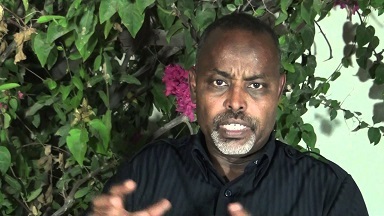
Mohammad (Tarzan) Nur
function. “The ICU are the right people to make peace in Somalia. No more clan rubbish.” Like Karzai in Afghanistan in the 1990s, he was willing to work with ICU and their ‘student’ allies, despite their radical Salafism, and hoped to be a bridge with the West, where he had established himself and his family.
Nur’s stint as mayor 2010–2014 was harrowing, with warlords controlling half of Mogadishu, and constant phone threats to kill him. Particularly tragic was the attack on a modest street festival in 2011 celebrating peace and reconstruction, where four civilians (including the brass band leader) were gunned down, and Nur barely escaped alive.
Finally, the warlords packed up and left Mogadishu two months after the festival debacle, and Nur was able to rebuild the power grid, pave roads, build schools, create a modest nightlife for Somalia’s capital. Mogadishu mayor Nur was not corrupt, like Karzai (jokingly referred to as the ‘mayor of Kabul’).
And he was not handicapped by US troops on street corners and making night raids. His success as mayor is grounds for hope. Imperialism is not ‘the only alternative’.
Somalis like the remittances from relatives abroad, but they also resent the fact that emigres lived a relatively easy life when most Somalis were suffering at home, much as do Afghans, which means that it is not the Karzais and Nurs who must lead the country.
The imperial saga continues to unfold. Somalis’ and Afghans’ dreams of socialism are more or less dashed, but for Somalis and Afghans old enough to remember, their days of socialism in the 1970s are fond memories, before the lure of empire (Somalia) and secularism (Afghanistan) took over, masterfully manipulated by the US. The future of both countries is still sorry, but the experience of their collapse and struggle is rich with lessons for both, and for the US.
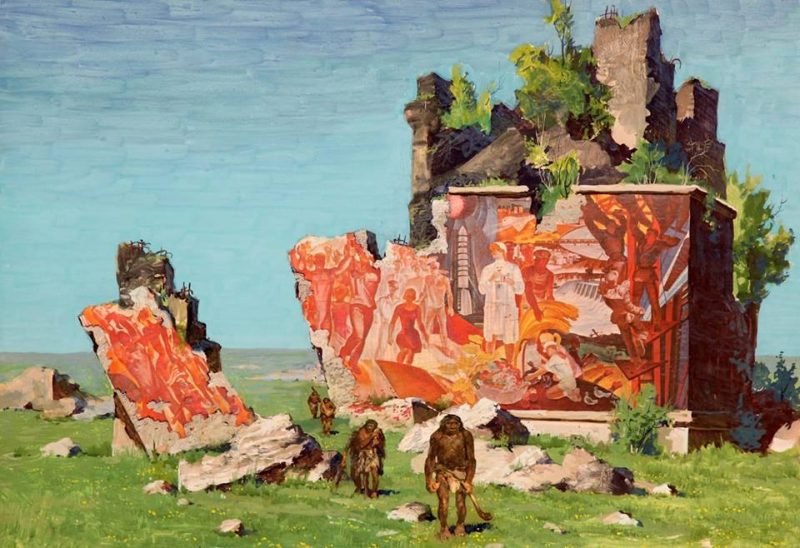

By Eric Walberg
The 21st Century
http://ericwalberg.com/index.php?option=com_content&view=article&id=732:somalia-afghanistan-a-tale-of-two-failed-states&catid=42:peace-and-socialism&Itemid=95
